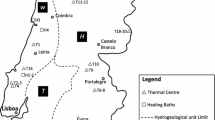Abstract
Turkey lies on the Alpine-Himalayan belt which is one of the most important geothermal belts in the World. Therefore, there are numerous mineral waters in Anatolia where geological and tectonic activities are intense. Archeological studies conducted in Anatolia, which is the cradle of various civilizations, reveal the fact that mineral water has been used as a spa in many areas.
The scope of this study is to evaluate mineral waters in Western Anatolia and their use in thermal resorts for balneological purposes. In this respect, 50 thermal waters used in spa centers were analyzed for various physical, chemical and bacteriological parameters.
Among the 50 waters tested, 40 are thermomineral waters while 10 are acratothermal waters. Some of these waters have distinct chemical compositions. Their temperatures are between 21 and 90 °C. Various types of mineral water source occur within this region: 5 of these are sulfurous, 1 has carbon dioxide, 29 have fluorine, 1 has iodine and 3 are saliferous. The thermomineral sources with saline characteristics have balneotherapy potential for treating skin illnesses including psoriasis and rheumatological illnesses.
Some waters with appreciable bicarbonate and sulfate concentrations can also be used for balneotherapy; for example for use as a cure for chronic inflammatory diseases of gastrointestinal and urinary systems. They could also be used as a cure for prophylactic and metaphylactic treatment of urolithiasis.
However, among 38 sampling sites, 12 sites are bacteriologically contaminated. This indicates that regulations governing the protection of such zones are not properly enforced and that water sources within these regions are not sufficiently protected or inspected.












Similar content being viewed by others
References
Akat U and others (1975) Menderes Masifi Güneyi GB Toros Kusagı Iliskisi,(on rapor). MTA Raporu No.5488, Ankara, 58 pp
APHA, AWWA, WEF (American Public Health Association, Water Environment Federation) (1989) Standard methods for the determination of water and wastewater. American Public Health Association, Washington, DC, 1391pp
Barnes S and others (1978) Global distribution of carbon dioxide discharges and major zones of Seismicity. U.S. Geological Survey Resources Investigations, Open-File Report, vol 132, pp 72–79
Barut IF (2001) Milas (Mugla)-Ekinambarı ve Savran Tuzlu Kaynaklarının Hidrokimyasal Arastırması. PhD Thesis, I.U. Fen Bilimleri Enstitusu, Istanbul, 189 pp
Dogal Kaynak (1997) MADEN VE IÇME SULARI İLE TIBBI SULARIN ISTIHSALI, AMBALAJLANMASI VE SATIŞI HAKKINDA YONETMELIK. Resmi Gazete 18.10.1997, Sayı 23144
Duchi V and others (1991) Chemical relationship between discharging fluids in the Siena-Radicofani Graben and the deep fluids produced by the geothermal fields of Mt. Amiata, Torre Alfina and Latera (Central Italy). J Volcanol Geotherm Res 31:401–413
Ercan T (1979) Batı Anadolu, Trakya ve Ege adalarındaki Senozoyik volkanizması. Jeoloji Muh Dergisi, Sayı:9
Fyfe WS, Price FJ, Thompson AB (1978) Fluids in the Earth’s crust. Elsevier, Amsterdam, 382 pp
Graciansky, PC (1965) Menderes Masifi Guney Kıyısı Boyunca Gorulen Metamorfizma Hakkında Acıklamalar. MTA Dergisi, 64 pp
Graciansky PC (1972) Recherches Geologiques Dans Le Taurus Lycien. Fac Sci Universite Paris-Sud (Orsay), vol 896, 762 pp
Hem JD (1965) Study and interpretation of the chemical characteristics of natural Water, 2nd edn. Geological Survey Water-Supply Paper 1473, US Government Printing Office, Washington, DC, 269 pp
Piper AM (1953) A graphic procedure in the geochemical interpretation of water analyses. US Geol Survey, Groundwater Note 12
Sahinci A (1991) Yeraltısuları Jeokimyası. D.E.Üni Muh Mim Fak Yayını, 394 pp
Turkiye Jeotermal Envanteri (1996) Maden Tetkik ve Arama Genel Mudurlugu. Ankara
Türkman M (1972) Su Kimyası Calısmaları Rehberi. DSİ Matbaası, Ankara
Acknowledgements
This research has been supported by the Istanbul University Research Fund (Project No: 874/090896). The authors would like to thank to Dr.Bio. H.Demirtas for conducting the biological analyses. We also extend our warmest thanks to Prof.Dr. Namık Yalçın.
Author information
Authors and Affiliations
Corresponding author
Rights and permissions
About this article
Cite this article
Barut, I.F., Erdogan, N. & Basak, E. Hydrogeochemical evaluation of Western Anatolian mineral waters. Env Geol 45, 494–503 (2004). https://doi.org/10.1007/s00254-003-0904-0
Received:
Accepted:
Published:
Issue Date:
DOI: https://doi.org/10.1007/s00254-003-0904-0




